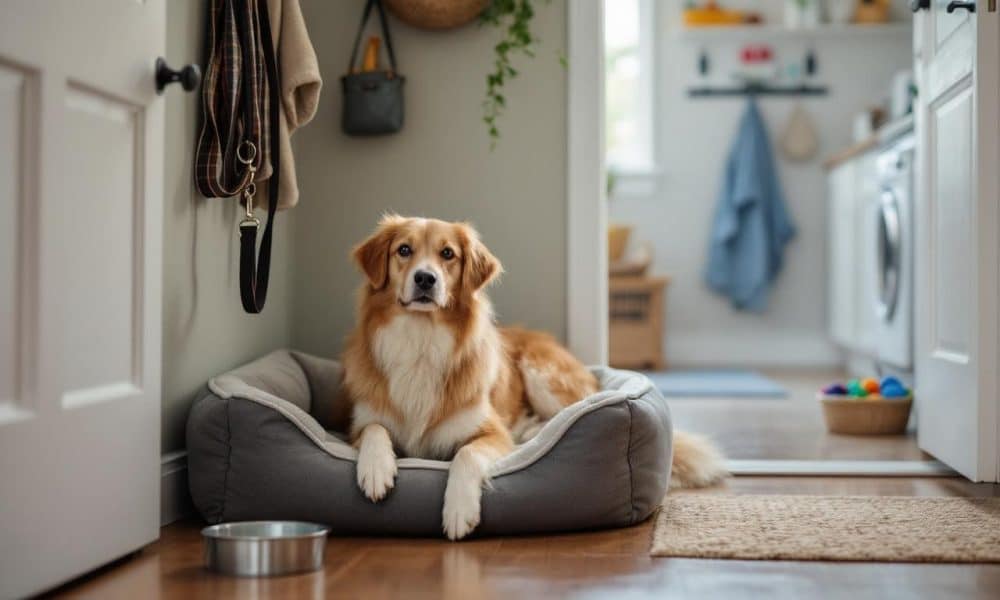
“This post contains affiliate links, and I will be compensated if you make a purchase after clicking on my links.”
Bringing a rescue dog home is a rewarding experience that requires careful preparation and patience. At DogingtonPost, we’ve compiled essential tips for bringing a rescue dog home to help you navigate this exciting journey.
Our guide covers everything from setting up your living space to building trust with your new furry friend. By following these steps, you’ll create a smooth transition for your rescue dog and set the foundation for a lasting bond.
How to Prepare Your Home for a Rescue Dog
Secure Your Living Space
Dog-proofing your home is the first step in welcoming a rescue dog. Tuck or hide cords under furniture so they cannot reach them, or conceal them with a flexible spiral wrap, cord concealer, or plastic piping, to keep them out of reach. Store cleaning supplies out of reach, and move fragile items to higher shelves. The ASPCA warns that common household plants like lilies and sago palms are toxic to dogs, so remove these or place them in inaccessible areas.
Create a Cozy Sleeping Area
Your rescue dog needs a designated space to feel safe. Choose a quiet corner of your home and set up a comfortable bed or crate. Line it with soft blankets and include a few toys. This area will serve as your dog’s sanctuary (especially during the initial adjustment period).
Stock Up on Essentials
Before your new dog arrives, gather all necessary supplies. This includes:
- High-quality dog food (preferably the same brand used at the shelter to avoid digestive issues)
- Sturdy food and water bowls
- A collar with ID tags
- A leash
- A variety of toys
- Waste bags for walks
- Enzymatic cleaners for potential accidents
The American Kennel Club recommends selecting age-selecting age-appropriate toys and food to support your dog’s specific needs. Senior dogs might benefit from orthopedic beds, while puppies need teething toys.


Outdoor Safety Measures
If you have a yard, ensure it’s securely fenced with no gaps or holes where your dog could escape. Remove any potentially harmful plants or chemicals from the area. Create a designated potty area to help with house training. Most adopters have to deal with housetraining to some degree. Patience, a strict schedule, good cleaning methods and supervision are all the keys to having a successfully housetrained dog. Always supervise your rescue dog outdoors initially, as they may attempt to escape due to stress or confusion in their new environment.
Prepare for the First Night
Set up a comfortable sleeping area for your dog’s first night home. This could be a crate in your bedroom or a dog bed nearby. Include familiar items from the shelter (if possible) to provide comfort. Keep water accessible and try to maintain a calm environment to help your new pet settle in.
These preparations will help reduce stress for both you and your new rescue dog. As you complete these steps, you’ll find yourself eager to welcome your new family member. The next phase of your journey involves helping your rescue dog adjust during those critical first few days.
Navigating the First Days With Your Rescue Dog
Setting a Consistent Schedule
Establish a routine immediately. Feed your dog at the same times each day, and stick to regular potty breaks and walks. The American Society for the Prevention of Cruelty to Animals (ASPCA) recommends taking your dog out every 1-2 hours initially. This consistency reduces anxiety and speeds up house training.
Gradual Home Exploration
Allow your rescue dog to explore their new environment at their own pace. Start by confining them to one or two rooms, then expand their access as they become more comfortable. This approach prevents overwhelming your new pet and allows for easier supervision.
Minimizing Stress and Overstimulation
Limit visitors during the first week. Too many new faces can overwhelm your rescue dog. Keep interactions calm and quiet. If children are present, supervise all interactions and teach them to respect the dog’s space. It’s best to introduce dogs in a “neutral space” outside of the home.
Provide a quiet space where your dog can retreat when feeling overwhelmed. This could be their crate or a designated corner with their bed. Respect this space and teach family members to do the same.


Patience is Key
Your rescue dog needs time to decompress. Some dogs may take days or even weeks to show their true personality. Don’t force interactions or training sessions. Instead, let your dog come to you when they’re ready.
Observe your dog’s body language. Signs of stress include excessive panting, yawning, or licking lips (these behaviors often indicate discomfort). If you notice these, give your dog some space. The Association of Professional Dog Trainers emphasizes the importance of reading canine body language to understand your dog’s comfort level.
Positive Reinforcement and Bonding
As your dog settles in, start to introduce positive reinforcement techniques. Positive reinforcement plays a pivotal role during training sessions. Rewards, such as treats or praise, encourage good behavior and solidify trust. Try short, fun training sessions (5-10 minutes) to engage your dog’s mind and reinforce basic commands.
Spend quality time with your new companion through gentle play and quiet companionship. This helps your dog associate you with positive experiences and lays the foundation for a strong relationship.
As you navigate these first days, you’ll notice your rescue dog becoming more comfortable in their new home. This gradual adjustment sets the stage for the next phase: building a deeper bond and trust with your new furry family member.
How to Build Trust With Your Rescue Dog
Use Positive Reinforcement
Positive reinforcement forms the foundation of trust with your rescue dog. Reward your dog with treats, praise, or toys when they display good behavior. This method proves more effective than punishment. A study showed that dogs trained with aversive methods displayed more stress-related behaviors, were more frequently in tense and low behavioral states, and panted more compared to those trained with positive reinforcement.
Establish Consistent Quality Time
Create a daily routine that includes dedicated playtime and exercise. This helps your dog burn off energy and strengthens your bond. The American Kennel Club suggests that the amount of daily activity needed varies from dog to dog and is dependent on age, health, and breed. Try activities like fetch, tug-of-war, or agility training to keep things interesting.
Honor Your Dog’s Personal Space
Every dog needs a safe space to retreat when feeling overwhelmed. This could be their crate, a specific bed, or a quiet corner. Never force your dog to interact when they’re in this space. Respect for these boundaries helps your dog feel secure and in control, which builds trust.
Introduce New Experiences Gradually
Expose your rescue dog to new experiences slowly and positively. This could include car rides, meeting new people, or visiting dog-friendly places. Start with short, low-stress exposures and increase duration and intensity over time. If your dog shows signs of stress (such as excessive panting or tucking their tail), take a step back and try again later.
Practice Patience and Consistency
Every rescue dog is unique and may have different comfort levels based on past experiences. Some may take weeks or months to fully adjust and trust. The key is to remain patient and consistent in your approach. With time and effort, you’ll see your rescue dog’s personality shine through, and you’ll develop a deep, rewarding bond.


Final Thoughts
Bringing a rescue dog home requires patience, understanding, and preparation. Our tips for bringing a rescue dog home will help you create a smooth transition and build a lasting bond with your new companion. You’ll witness your dog’s personality blossom and their trust grow as they settle into their new life.
We at DogingtonPost advocate for rescue dog adoption and offer ongoing support for dog owners. Our resources cover health, nutrition, and heartwarming stories of rescue successes. We encourage you to consider adoption when adding a new pet to your family.
Adopting a rescue dog is the beginning of a beautiful adventure that will enrich your life for years to come. Your new furry friend will reward your efforts with unwavering loyalty and affection. Shelters and rescue organizations have wonderful dogs of all ages, sizes, and breeds waiting for their forever homes.










